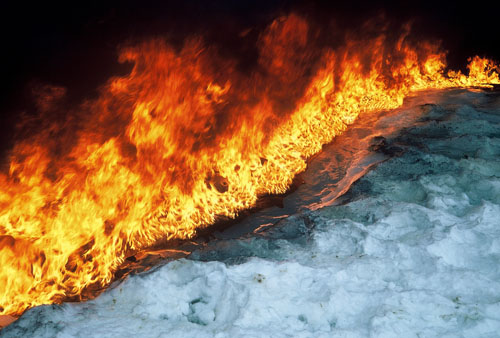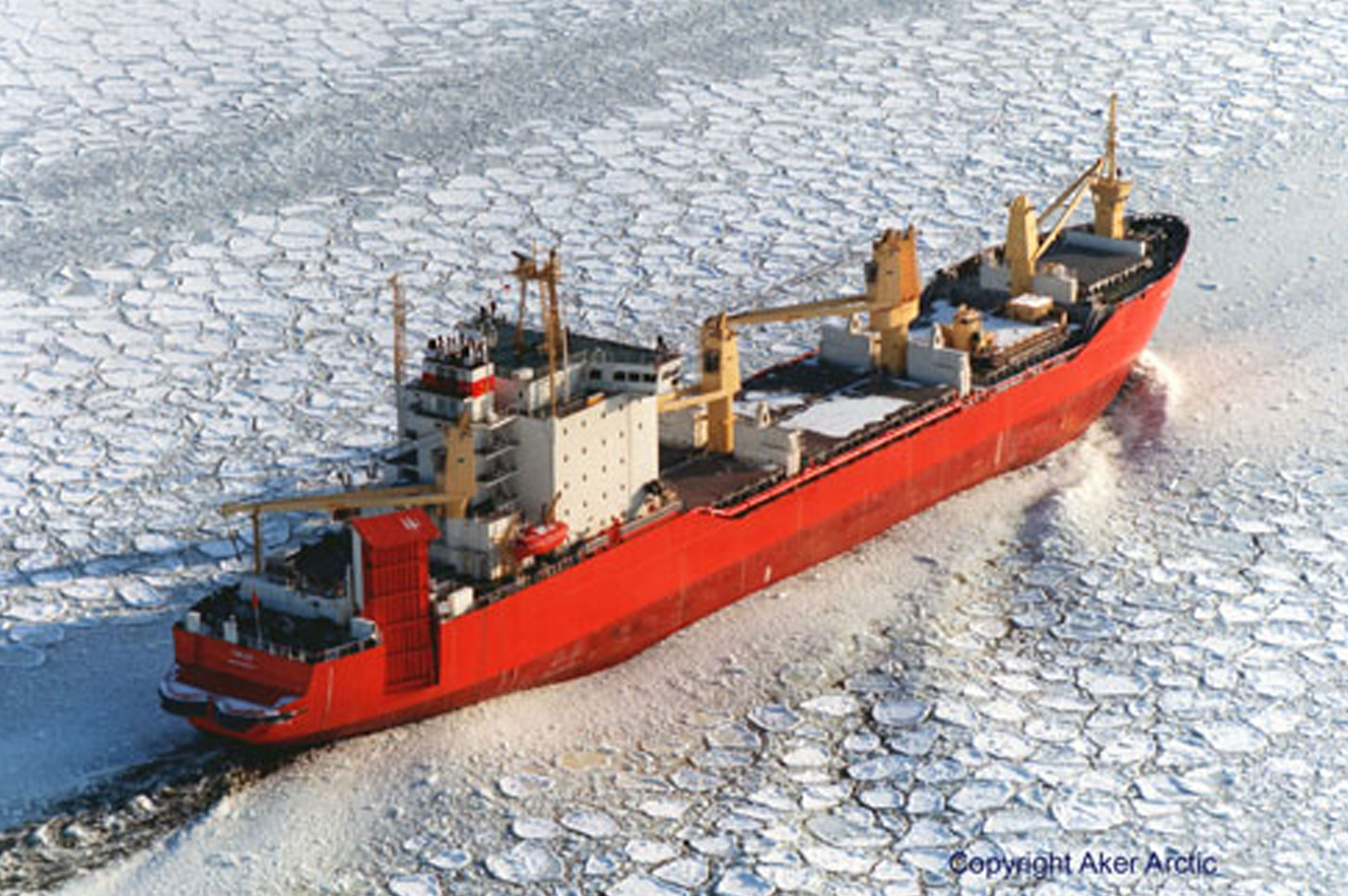Review of Methods to Deal with Accidental Spills in Ice-Covered Waters
for StatoilHydro, Norway 2007-08 Hylje
The study scope covered a wide range of topics: overview of response infrastructure, political and regulatory issues, local sensitivities, sea ice environments, fate and behaviour of oil, response methods and an overall assessment of response applicability in the different regions with a summary of response capability.
ACG/BTC Oil Spill Response Plan Review
with Polaris Applied Sciences for the Lenders,2004-2005
Dickins Associates assisted Polaris Applied Sciences in reviewing a series of Oil Spill Response Plans for a massive $3 billion oil production project designed to move a million barrels of oil per day through an 1,800 km pipeline from offshore ACG oil fields in Azerbaijan, through Georgia to a new tanker terminal at Ceyan in Turkey. An exhaustive review was conducted for the European Bank for Reconstruction and Development (EBRD) on behalf of the lenders. As part of the process, David Dickins participated in a site visit to Baku with other members of the technical team at the onset of the review in 2004. In August 2005, Mr. Dickins represented the World Bank and EBRD in evaluating a full-scale deployment and spill drill at the new oil terminal in Ceyan. The inaugural shipment of about 600,000 barrels of crude oil was delivered by tanker to Savona, Italy in June 2006, marking the start of export of Azerbaijan’s crude oil via the BTC oil pipeline.
Training for Winter Oil Spill Response
for St. Lawrence Seaway Authority, Massena NY, Feb 2003 Dickins assisted Polaris Applied Sciences in putting on a highly successful
Dickins assisted Polaris Applied Sciences in putting on a highly successful three day training course, focusing on spill behavior in fast flowing waters with ice. There is a risk of accidental spills from cargo vessels moving through the Seaway late in the season. The course program included a mix of classroom sessions and field exercises. A brochure describes the joint winter response training capabilities of Polaris and Dickins.
Best Practices for Oil-in-Ice Response in the Caspian Sea
for Statoil, Stavanger, 2002
The company prepared a comprehensive evaluation of ice conditions and realistic response strategies to deal with several possible spill scenarios at different locations in the North Caspian Sea. The project made extensive use of astronaut imagery acquired during Shuttle and MIR missions.
Alpine Spill Response
for Phillips Alaska Inc. with Polaris Applied Sciences Inc., 2002
Dickins evaluated the ice conditions off the Colville River Delta with the objective of identifying potential pathways whereby a surface spill from proposed oil developments could interact with nearshore sea ice in shallow water. Paper presented at AMOP 2002.
USGS – Landsat 7
Oil in Ice at Ohmsett
for SL Ross Environmental Research Ltd. (Client: US Minerals Management Service)
2002 Dickins assisted SL Ross in developing options for introducing sea ice into an existing outdoor test tank in New Jersey and participated in the initial field trials to test a skimmer in a manufactured broken ice sheet at the Ohmsett facility.
Detection and Tracking of Oil Under Ice
for the United States Minerals Management Service,
Department of Interior, April 2000 Dickins submitted a successful “white paper” in response to a call for research proposals to assess the available technology to detect and track an oil spill under ice in the Arctic Ocean.
Advisor to Marine Risk Management Panel
for Washington State Department of Ecology and United States Coast Guard, 1999
Dickins as selected as a technical advisor to work with a federally appointed panel representing the marine industry, government agencies and environmental groups looking at ways to reduce the risk of oil spills related to shipping in the Pacific Northwest area of Puget Sound.
Cross Cascade Pipeline Application
for Tidewater Barge Lines, Portland, 1996 to 1999
Dickins acted as an expert witness in providing testimony and opinions on the relative risks of moving oil by barge and pipeline with respect to an application to build a new pipeline to connect Seattle with Eastern Washington. Responsibilities including reviewing and critiquing work of other experts and undergoing cross examination before a federal review panel.
Rescue and Escort Tugs for Tankers
for Robert Allan Ltd., RCG/Haglar Bailly, 1995 (Clients: Canadian Coast Guard, British Columbia Government)
These studies examined the potential costs and benefits associated with deploying a mix of rescue and escort tugs across Canada, and a dedicated rescue/salvage tug off the West Coast. The objective was to determine whether tug escorts could significantly reduce the frequency of oil spills from tankers.
Conference on Oil Spill Response in Dynamic Broken Ice
for Cook Inlet Spill Prevention and Response, March 1994
Dickins Associates organized and facilitated a highly successful conference held in Anchorage. The focus of the program developed with the cooperation of the local US Coast Guard MSO, was to understand and develop effective strategies for dealing with oil spills in an environment similar to Cook Inlet, Alaska, with strong tidal streams and floating ice.
Evaluation of Unsolicited Proposals for Oil Spill R&D
for the Marine Spill Response Corporation, Washington DC., 1993 to 1995
Dickins Associates was selected through competitive bid to act as the agent for MSRC in reviewing all unsolicited proposals and ideas submitted worldwide to the organization. The work involved screening novel oil spill countermeasures ideas for possible funding. The contract ceased when the research arm of MSRC was disbanded in 1995.
“Ice is Nice” Brochure
for Amoco Eurasia Petroleum Company and Canadian Marine Drilling Limited, 1993
Dickins was contracted to develop a full colour marketing handbook highlighting the state of practical knowledge on dealing with oil spills in ice. Detailing appropriate strategies in different seasons, the brochure traces the history of Canadian research efforts in this area over the past fifteen years, focusing on experiences in the Beaufort Sea. The document was published in Russian and English.
Canmar
Inventory of Facilities/Sites for Disposal of Oily Waste
for BC Environment and Burrard Clean Operations Limited, 1993
Dickins Associates conducted a comprehensive survey of all facilities within British Columbia that might have a capability to assist in the disposal or storage of oily waste arising from marine oil spills.
Dickins Associates conducted a comprehensive survey of all facilities within British Columbia that might have a capability to assist in the disposal or storage of oily waste arising from marine oil spills.
Review of Oil Spill Cleanup Costs
for an oil industry client (subcontract to Coastal & Ocean Resources Inc.), 1992
Dickins Associates reviewed the cleanup costs associated with nine recent spills worldwide. Data was further broken down into shoreline versus marine components of the cleanup in order to compare the cost per barrel of oil recovered for both types of cleanup.
Beaufort Sea Oily Waste Disposal Sites
for Environment Canada, 1992
Dickins directed a project to evaluate and recommend potential oily waste disposal sites along the Beaufort Sea coast. The results of this study can be used to recommend final sites for possible pre-approval by the different agencies and native organizations in the Yukon and the NWT.
Environmental Sensitivity and Risk Analysis along a Tanker Route
for Transport Canada (subcontract to Canarctic Shipping Co. Ltd.), 1992
Dickins Associates evaluated the environmental sensitivity of a tanker route from the Canadian High Arctic to Montreal. Human use, biological resources, special status areas, and shoreline sensitivities were evaluated on each segment of the route in order to compare relative spill risks.
Canarctic (FedNav)
Comparative Oil Spill Risk of Marine Areas
for Canadian Coast Guard with AECL Research, 1992
The relative sensitivity of different Canadian marine areas to 10,000 tonne oil spills was evaluated, and the probability of marine accidents was calculated using historical vessel casualty and traffic data.
Comparative Risk Evaluation of Tankers and Pipelines
Trans Mountain Pipeline Company Limited (subcontract to Dames and Moore), 1990 and 1992
Dickins Associates evaluated the differences in marine spill risk, which would result if a new offshore oil terminal was built at Low Point on the Olympic Peninsula in Washington State.
Shoreline Cleanup Options: Performance and Effects Vancouver Island and North Coast Surveys, April 1991 to Sept 1992
for Environment Canada Over two years,
Dickins Associates conducted an extensive screening and site assessment along the north coast of Vancouver Island and northern B.C. (from the Alaskan border south) in search of sites suitable for a series of shoreline oil spill experiments designed to evaluate the effects and effectiveness of different shoreline cleanup methods in a controlled setting.
In-Situ Burning Workshop
for Alaska Clean Seas, 1991
Dickins facilitated an international workshop held in Anchorage. Over 160 people discussed the technical, environmental, and social aspects of burning as a viable oil spill clean-up technique.
Strategies for Remote Sensing and Trajectory Modelling in Support of Oil Spill Response
for Environment Canada, Conservation and Protection, 1991
Dickins Associates facilitated two workshops held in June 1991 to survey user requirements and establish the outline of a national strategy for remote sensing and trajectory modeling.
Oil Spill Response Atlas for the Southwest Coast of Vancouver Island
for the B.C. Ministry of Environment, 1990
This computer generated atlas maps shoreline sensitivities, identifies priority areas and makes specific recommendations for oil spill response strategies.
Environmental Risks of Oil Tanker Traffic on the West Coast (2 vols.)
for the States/British Columbia Task Force on Oil Spills, 1990
Dickins Associaters was the principal consultant to the States/B.C. Task Force on spill risk analysis. Five detailed spill scenarios are developed in terms of the environmental consequences and cost.
Dickins Associaters was the principal consultant to the States/B.C. Task Force on spill risk analysis. Five detailed spill scenarios are developed in terms of the environmental consequences and cost.
Tanker/Barge Safety
for the States/British Columbia Task Force on Oil Spills, 1989-90
This study evaluated proposed measures for reducing the risk of oil spills from tankers and barges along the West Coast and made recommendations on the effectiveness of different improvements.
Blowout Analysis in a Worst Case Summer, December
for Gulf Canada Resources Inc., December 1990
This analysis involved developing probable areas of influence for oil spilled into broken ice during a severe ice year in the Beaufort Sea. Dickins carried out this work in response to concerns raised during environmental hearings into arctic offshore drilling.
Evaluation of Tank and Basin Facilities
for Environment Canada and the U.S. Minerals Management Service, 1989
Dickins reviewed all available towing tanks and maneuvering basins in Canada and the United States against a set of requirements for testing oil spill response equipment.
Oil Spill Trajectory Models
for Gulf Canada Resources Limited, 1989-1990
This project evaluated available trajectory models in North America and Europe in terms of their ability to accurately predict the movement of oil spilled in open water and ice on a real-time basis.
Newfoundland Oil Spill Exercise – Meteorological Conditions
for S.L. Ross Environmental Research Limited, 1987
Dickins documented sea conditions and climate during the largest experimental spill of crude oil ever conducted in North America (18,000 gallons of oil, five large vessels and over 100 personnel). The joint U.S./Canada project afforded an unequaled opportunity to observe the capabilities of different oil spill containment booms and skimmers in the open ocean.
Air Deployable Oil Spill Igniter Tests, Yellowknife
for Canadian Marine Drilling Ltd. and the Arctic Petroleum Operators Assoc., 1979
A series of prototype igniters were dropped from a helicopter into an oiled melt-water pool, on the ice surface of a small lake. Over 90% of the oil was burned and recommendations made for improvements to future igniter design.
Eastern Arctic Blowout Scenarios
for inclusion in Canadian Government Major Oil Blowout Contingency Plan for the Eastern Arctic, 1979
The Labrador Sea, Davis Strait, Lancaster Sound and Beaufort Sea areas were compared in terms of the physical environment affecting oil spill contingency planning. A worst-case blowout scenario was developed for a Davis Strait drill site in 800 m of water with a dynamic broken ice cover.





